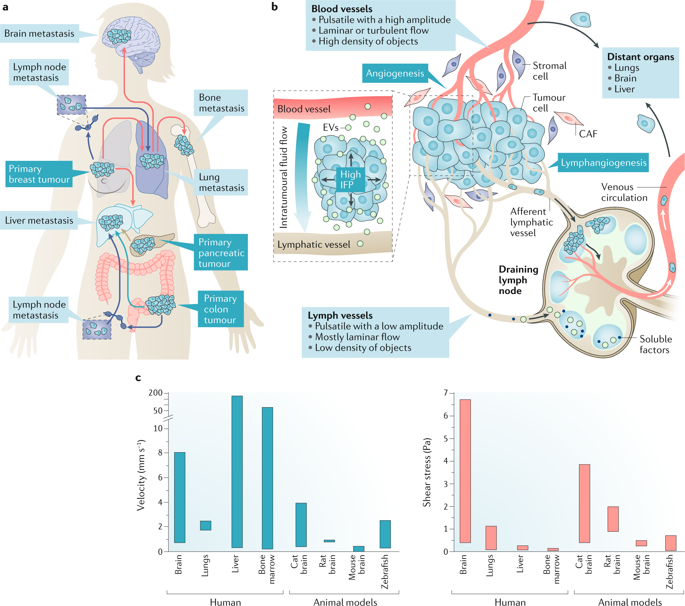当前位置:
X-MOL 学术
›
Nat. Rev. Cancer
›
论文详情
Our official English website, www.x-mol.net, welcomes your
feedback! (Note: you will need to create a separate account there.)
Fluids and their mechanics in tumour transit: shaping metastasis.
Nature Reviews Cancer ( IF 72.5 ) Pub Date : 2019-11-28 , DOI: 10.1038/s41568-019-0221-x Gautier Follain 1, 2, 3 , David Herrmann 4, 5 , Sébastien Harlepp 1, 2, 3 , Vincent Hyenne 1, 2, 3, 6 , Naël Osmani 1, 2, 3 , Sean C Warren 4, 5 , Paul Timpson 4, 5 , Jacky G Goetz 1, 2, 3
Nature Reviews Cancer ( IF 72.5 ) Pub Date : 2019-11-28 , DOI: 10.1038/s41568-019-0221-x Gautier Follain 1, 2, 3 , David Herrmann 4, 5 , Sébastien Harlepp 1, 2, 3 , Vincent Hyenne 1, 2, 3, 6 , Naël Osmani 1, 2, 3 , Sean C Warren 4, 5 , Paul Timpson 4, 5 , Jacky G Goetz 1, 2, 3
Affiliation

|
Metastasis is a dynamic succession of events involving the dissemination of tumour cells to distant sites within the body, ultimately reducing the survival of patients with cancer. To colonize distant organs and, therefore, systemically disseminate within the organism, cancer cells and associated factors exploit several bodily fluid systems, which provide a natural transportation route. Indeed, the flow mechanics of the blood and lymphatic circulatory systems can be co-opted to improve the efficiency of cancer cell transit from the primary tumour, extravasation and metastatic seeding. Flow rates, vessel size and shear stress can all influence the survival of cancer cells in the circulation and control organotropic seeding patterns. Thus, in addition to using these fluids as a means to travel throughout the body, cancer cells exploit the underlying physical forces within these fluids to successfully seed distant metastases. In this Review, we describe how circulating tumour cells and tumour-associated factors leverage bodily fluids, their underlying forces and imposed stresses during metastasis. As the contribution of bodily fluids and their mechanics raises interesting questions about the biology of the metastatic cascade, an improved understanding of this process might provide a new avenue for targeting cancer cells in transit.
中文翻译:

肿瘤转运中的液体及其力学:成形转移。
转移是一系列动态事件,涉及肿瘤细胞向体内遥远部位的扩散,最终降低了癌症患者的生存率。为了定居远处的器官并因此在生物体内系统地扩散,癌细胞和相关因素利用了几种体液系统,这些系统提供了自然的运输途径。确实,可以选择血液和淋巴循环系统的流动力学来提高癌细胞从原发肿瘤,外渗和转移性种子转移的效率。流速,血管大小和切应力都可以影响癌细胞在循环中的存活并控制趋向性播种方式。因此,除了使用这些液体作为在整个身体中传播的手段外,癌细胞利用这些液体中的潜在物理力成功播种远处转移。在这篇综述中,我们描述了循环中的肿瘤细胞和肿瘤相关因子如何在转移过程中利用体液,其潜在作用力和施加的压力。随着体液的贡献及其机理提出了有关转移级联生物学的有趣问题,对这一过程的进一步了解可能为靶向转运中的癌细胞提供新途径。
更新日期:2019-11-28
中文翻译:

肿瘤转运中的液体及其力学:成形转移。
转移是一系列动态事件,涉及肿瘤细胞向体内遥远部位的扩散,最终降低了癌症患者的生存率。为了定居远处的器官并因此在生物体内系统地扩散,癌细胞和相关因素利用了几种体液系统,这些系统提供了自然的运输途径。确实,可以选择血液和淋巴循环系统的流动力学来提高癌细胞从原发肿瘤,外渗和转移性种子转移的效率。流速,血管大小和切应力都可以影响癌细胞在循环中的存活并控制趋向性播种方式。因此,除了使用这些液体作为在整个身体中传播的手段外,癌细胞利用这些液体中的潜在物理力成功播种远处转移。在这篇综述中,我们描述了循环中的肿瘤细胞和肿瘤相关因子如何在转移过程中利用体液,其潜在作用力和施加的压力。随着体液的贡献及其机理提出了有关转移级联生物学的有趣问题,对这一过程的进一步了解可能为靶向转运中的癌细胞提供新途径。




















































 京公网安备 11010802027423号
京公网安备 11010802027423号